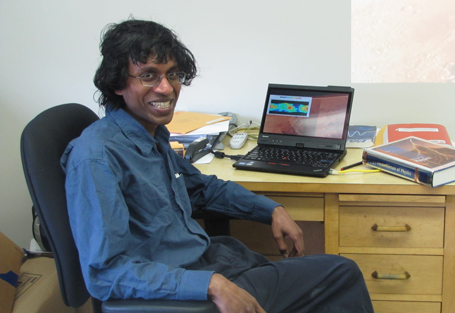Tuesday, May 15, 2012
Rider’s Dr. Suniti Karunatillake and his colleagues use data taken during missions in order to learn more about our planetary neighbor, Mars.
by Meaghan Haugh, M.A. '11
As a child in Sri Lanka, Dr. Suniti Karunatillake grew up watching celebrated astronomer Dr. Carl Sagan’s documentary series, Cosmos: A Personal Voyage, and became fascinated by the possibility of life beyond earth.
“I would look out at the stars at night, wishing someday I could make contact with aliens,” Karunatillake remembers.
These days, Karunatillake has less time to gaze at stars, but he has held on to his childhood dream. Today, he is a planetary scientist, researching the surficial geochemical processes — the change in the chemical composition of rocks and minerals — primarily on Mars.
Karunatillake joined the Rider faculty as an assistant professor of Chemistry, Biochemistry, and Physics in the fall, and is continuing Martian research, which he started during his postdoctoral fellowship at the SUNY-Stony Brook Research Foundation.
Through the NASA-funded Mars Data Analysis Program, Karunatillake and researchers from Rider University, Cornell University, Georgia Tech, Stony Brook University, the University of Arizona, and Université de Toulouse (France) are conducting several investigations using mission data taken on Mars. In particular, the team is investigating (1) In what manner is water present in the Martian subsurface across continental scales at meter-scale depths?; (2) Was the Thaumasia plateau on Mars created by a giant landslide or some other processes?; (3) How to characterize soil types on Mars using grain sizes?; and (4) What does the subsurface chemistry of the Elysium volcano tell about its origins?
“Once you become really close to a planet, it becomes really accessible,” he said.
Recently, Karunatillake presented some of the research’s key findings on hydrous sulfates on Mars at the 43rd Lunar and Planetary Science Conference in Texas in March, and the Astrobiology Conference at Georgia Tech in April. In particular, the team has determined that it seems much of the water seen in the Martian midlatitudinal areas can be contained in water-bearing iron-sulfates.
Though previous research reveals a dominance of other hydrous minerals, Karunatillake and his team predict that these differences may indicate vertical compositional layers on Mars. In addition, Karunatillake said that hydrous iron sulfates melt at lower temperature, offering a possible source for brines — saturated salty waters — for seasonal debris flows, which are described as “liquefied landslides” of dust and soil.
“Such seasonal flows could also be interesting for the habitability for microbes, though much higher water activity would be needed,” he said.
Karunatillake, who holds doctoral and master’s degrees in Physics, Astronomy and Planetary Science from Cornell University, became involved with the NASA research through his graduate adviser, Dr. Steven Squyres, Goldwin Smith Professor of Astronomy at Cornell and the principal investigator for NASA’s Mars Exploration Rover Mission.
Karunatillake’s involvement in the Martian research has already benefited the Rider community. At Rider, he is working with Dr. Jonathan Husch, chair of the Department of Geological, Environmental, and Marine Sciences (GEMS), Dr. Reed Schwimmer, associate professor of GEMS and Tom Weindl ’13, a Biochemistry major. They are engaged in a project that takes a look at characterizing soil types on Mars by using grain sizes. In particular they are focusing on imaging terrestrial soil samples, sieving them, and comparing the physically measured samples with the automated classification by the software they designed in collaboration with Wolfram's Image Processing Group. In addition, they are also exploring the origin of Home Plate in the Columbia Hills on Mars, a hydrothermal sediment bed. The Rider team will continue pursing these projects this summer and next fall.
Karunatillake shares his interest and research findings in his introductory physics and calculus classes at Rider.
“I often discuss the relevance of fundamental physics in planetary missions,” he said. “Recently, we discussed the type of spectrometer — diffraction grating versus prismatic — that would work best for a Martian mission given cost, weight, and durability concerns.”

